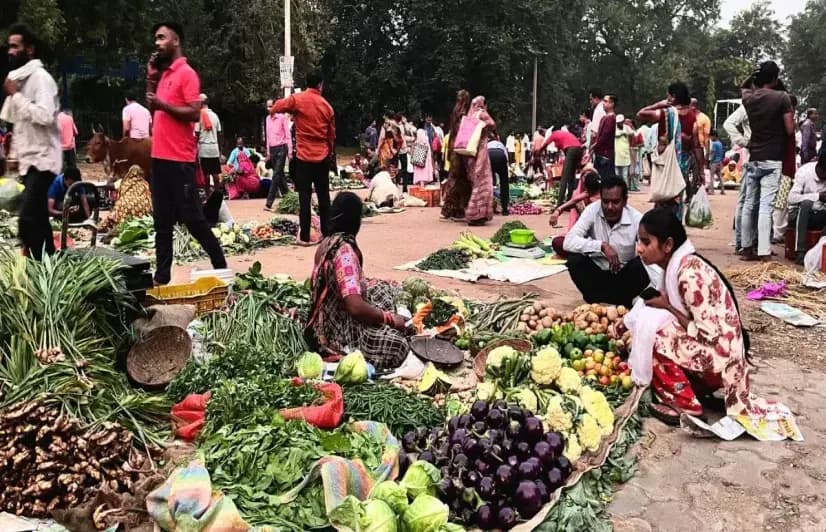Nepali migrant workers in apple orchards of Himachal Pradesh face the heat of climate change
-53.webp&w=3840&q=100)
Nepali migrant workers in apple orchards of Himachal Pradesh face the heat of climate change
Workdays in the orchards have come down to 70-90 days against the earlier 120-150 days, making orchard workers shift to construction labour and other similar work
Shimla, Himachal Pradesh: When Sushma (16) from Seemapur village of Nepal reached the apple orchard of Lata Devi on the outskirts of Shimla district in the second week of June, her aim was to earn Rs 30,000 to 50,000, in order to fund her nursing studies. She was just a helping hand and not a trained worker, who came here at the call of her parents. She was paid only Rs 250 per day.
Gopal Thapa (18), another labourer, reached the same farm in Himachal Pradesh from Seemapur just four days before Sushma arrived. He wanted to save Rs 75,000 to 1 lakh to pay off the loan his family had taken. He also wanted to buy a motorcycle.
The apple crop in Himachal Pradesh relies heavily on seasonal migrant labourers from Nepal, who come specifically for the season that starts from June and lasts up to October (ranging from 120 to 150 days). However, in recent times, changing weather patterns have been affecting these marginalised labourers who pluck fruits and carry apple loads. They now get work only for 70 to 90 days.
Five
years ago, the payment was around Rs 350 per day, and the season was long
enough to earn a decent income. Now, although the daily wage has increased to Rs
400 to 450, the season has shortened. Productivity has decreased, which has
also reduced the availability of work.
As a
result, Nepalis have been working as labourers in road construction, in dhabas and hotels, or serving as
caretakers of houses. These jobs do not provide the same earnings or benefits
that work in orchards gives.
Despite
the reduced activity, pruning, mulching, grass cleaning, fruit plucking, and
loading and unloading fruits have to be carried out in the orchards. While machines
perform many tasks, there is still a need for workers to operate these machines.
When
a Nepali family migrates, they often settle in Himachal Pradesh and visit Nepal
only once a year. Tilak Raj (54) from Kirtipur village in
Kathmandu district is one such person. A trained carpenter settled in Rohru, he
has worked across the state for almost two decades. Raj came to India at
the age of 14, initially working in a Delhi eatery, before learning carpentry
from a fellow Nepali migrant.
Raj has
noticed significant changes in the weather, with temperatures now much warmer
than a decade ago. He has worked in many apple orchards, including those in Theog,
Rampur, and Kinnaur. He recalled that in the past, snowfall would touch 3 to 5
ft. There was a time when they would load all the apple cartons on their backs.
However, times have changed; although facilities have improved, the amount of
fruit availability has decreased.
Despite their contributions to the local economy, Tilak and other Nepali migrants lack social security benefits such as ration cards and health insurance. He lost his first wife when she fell off a tree while working in an orchard. He was unable to provide proper medical treatment and the state or Central government made no such facility available.
Threat of climate change
According to the monthly weather report of India Meteorological Department, Shimla, this July received deficient rainfall, which was the lowest in 106 years. The highest rainfall in July for the period 1901-2024 was received in 1949 (548.6 mm). This shift in climatic conditions has severely impacted the fruit production and month of the season.
On the other hand, June was unusually dry, with very little overall rainfall compared to a normal year. The monsoon was not as active as it should have been, with only a couple of days of significant rain across the state. This June had the 105th lowest amount of rainfall in Himachal Pradesh since records began in 1901. The highest rainfall ever recorded in June was 252.7 mm back in 1971.
The state government has also accepted the change in climate and its impact on the apple crop. In the Economic Survey of Himachal Pradesh, 2023-24, the government mentioned: “The fluctuations in the production of apples during the last few years have attracted the attention of the government. The state is trying to explore and harness the vast horticulture potential of the hill state through diversified horticulture production in varied agro-ecological zones. The area under temperate fruits other than apples has increased.”
Currently, approximately 234 lakh hectares of land in the state are dedicated to horticulture, generating an average annual income of around Rs 5,000 crore. This sector provides direct and indirect employment to an impressive nine lakh people, highlighting its significance as a major source of livelihood. Horticulture occupies 26% of the state's total agricultural area (8, 91,926 hectares) and contributes 22% to the value of agricultural produce. In the 2022-23 period, the value of agricultural crops, including vegetables, was Rs 16,076 crore, while horticultural crops contributed Rs 4,476.64 crore.
Struggle for better income
Sheetal
Devi (26)
arrived in Himachal Pradesh four years ago. She initially worked in tomato
farms, before settling in one of the orchards in Matyana, about 45 km from
Shimla. This year, she could not work as she had recently delivered a baby. Her
husband also could not leave due to their young daughter needing care.
“We used
to earn more by working in orchards compared to tomato farms. Now, with no rainfall
from April to June, we are struggling to grow any crop,” Devi said.
Prem
Kumar (40) and his wife Nirmala Devi (30) from Jajarkot district of Nepal came
to Himachal Pradesh eight years ago. He worked hard and saved enough money to
purchase land in Nepal, but now things are changing. Kumar noted that lack of
snowfall has reduced the chilling period, which is crucial for apple production.
“In addition to apples, we also grow vegetables on the piece of land provided by the land owner. This year, water shortage and extreme heat destroyed the entire crop. We were unable to spray the crops in time, which further damaged them. We could not sell cauliflower from the land we got for cultivation free of cost from the landowner because the crop was destroyed due to lack of water and extreme heat,” Kumar said.
Kumar's
success and his ability to buy land in Nepal influenced his brother-in-law
Dhani Ram to come and work in Himachal Pradesh. Ram said that although they owned
land in Nepal, there was no proper mechanism to bring crops to market, and the
rates were very low. “Here, if we earn Rs 100, it
can become Rs 159 in Nepal — a significant difference,” he said,
though he is disappointed due to the poor season.
Lata
Devi, a farmer with nearly two decades of experience employing Nepali workers,
reflected on the challenges and importance of these workers. “We pay them
Rs 400 to 500, depending on the work. However, women are paid Rs 50 less
than the daily wage,” she said.
To retain labourers, she ensures that they are treated with utmost love and care; otherwise, they tend to leave. In addition to their wages, she provides them with a plot of land to grow vegetables or anything else, accommodation and sometimes a cow as well, without taking any share from their produce. Typically, she hires six to seven Nepali workers during good seasons. However, this year's poor crop meant that she can only afford one or two extra hands. Regarding climate change, Lata takes a fatalistic view, attributing agricultural outcomes to divine will rather than human influence.
Challenges in apple production
The data from the Department of Agriculture &
Farmers Welfare and the CEIC database report the fluctuations in apple
production in Himachal Pradesh. In 2024, apple production in Himachal Pradesh
was 580.296 thousand tonnes, down from 672.343 thousand tonnes in 2023. Over
the past decade, apple
production in the state has averaged around 580.296 thousand tonnes
annually. The highest production level was recorded at 777.126 thousand tonnes
in 2016, while the lowest was 275.036 thousand tonnes in 2012.
Dr DP Sharma,
Dean, Horticulture and Forestry College, Hamirpur, under the YS Parmar
University, explained the critical climatic conditions necessary for apple
fruit growth. “Due to insufficient snowfall, fruits do not complete their
necessary chilling period, affecting flowering. Later, extreme heat, due to no
rainfall and forest fires, also contribute to warming the temperature. This
year, temperatures above 30 degrees Celsius hampered fruit setting and growth. Apple
growth stops if the temperature goes above 30 degrees Celsius, and the size of
the fruit is crucial for market value. This season, prolonged dry spells and
extreme heat have stunted fruit growth, reducing yields and causing premature
fruit drop as well,” said the fruit expert.
However,
there is hope for higher regions where fruits ripen a little later. “Where production
happens in July, it will be severely affected,” said Dr Sharma, while mentioning
that the university is trying and experimenting with other varieties that can
survive in the current climatic situation.
Sushant Verma,
a young entrepreneur, finds it challenging to cope with the effects of climate
change. He is searching for early varieties of apples or varieties that can
withstand higher temperatures and require less water.
Regulatory mechanism
A former
state president of Mool Pravah Akhil Bharat Nepal Ekta Samaj, Jagraj Gharti
highlighted the sector's lack of regulation. He said they have been advocating
since 2004 for police verification of workers, a measure resisted by locals
fearing liabilities.
“Each
year, between 10,000 and 15,000 Nepalis arrive for the season, employed under
contractors or in manual labour roles such as fruit plucking and carrying. This
year, reduced production levels meant a shorter season, which meant work for a limited period only with daily wages set at Rs 500 for men and Rs 400 to Rs 450
for women.”
According
to Gharti, workers are sometimes made to work without payment, and at other
times, they are hired for as little as ₹350 a day, or just in the name of
food and shelter without money.
For the Nepalese, migrating to India is convenient as it does not require expensive air travel, passports or visas. There are no official restrictions for Nepalese to work in India. However, the downside is that there is no official body to ensure their well-being.
Would you like to Support us
101 Stories Around The Web
Explore All News
Jun 11
‘’मलेरियाने माझा मुलगा अन् नवरा बी मेला’’... गडचिरोलीमध्ये तापमान बदलाचा आणि डासांचा काय आहे संबंध?

Jun 11
ओडिशा : जलवायु चुनौतियों से निबटने मैंग्रोव संरक्षण के कार्य में जुटी महिलाओं की कहानी
-5.webp&w=3840&q=75)
Mar 27
A Painful Period In The Salt Pans Of Little Rann Of Kutch
-13.webp&w=3840&q=75)
Mar 27
Madhya Pradesh: Where is Our Free Time?

Feb 02
Dilemma Faced By Poor Farmers In Bundelkhand: Grow Organic While Selling Non-Organic

Feb 02
Giridih saves its village ponds with NITI Aayog's help

Jul 29
Odisha students use mobile cameras and pens to preserve village history
-18.webp&w=3840&q=75)
Jul 29
Rajasthan: Fasal Bima Yojana and the Art of Minimising Payouts
-16.webp&w=3840&q=75)
May 25
Waste to wealth: Bhopal district panchayat spends Rs 75,000 per month to earn just Rs 4.5 lakh a year

May 10
A Victory For Unmarried Rajasthani Women As Anganwadi Positions Open For Them
About the Reporter
Write For 101Reporters
Would you like to Support us
Follow Us On
Editor's Pick
Surviving on mercy: Temporary sanitation workers in rural Tamil Nadu earn less than minimum wage
How Kerala heatwaves are boiling over to construction workers’ personal lives
Empowering didis: In Burhanpur, management of ration shops is boosting women’s confidence and financial independence
No childhood in the mangroves: What is the climate change’s toll on Sundarbans youth
In the remote, tribal villages of Gadchiroli, climate change is breeding malaria
Discontent and misgovernance as Tamil Nadu postpones panchayat elections
Curse of the canal: Seepage and waterlogging lay waste to agriculture in Rajasthan's Luni delta
Assam's ‘left-behind’ women wage lonely, futile battle against extreme floods
'Now we want the chair': Kashmir’s women SHG leaders gear up to fight panchayat elections
Recommended Topics
-56.jpg)
-46.jpg)
-57.jpg)
-58.jpg)
-53.webp&w=3840&q=75)
-59.webp&w=3840&q=75)
